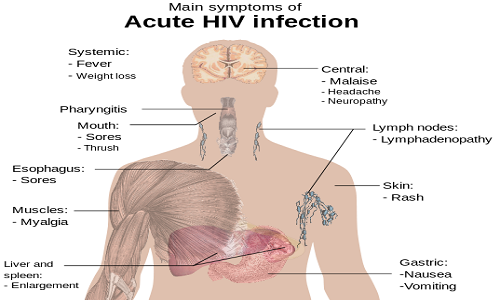Difference Between HIV/AIDS And FLU
Human Immunodeficiency Virus infections are an array of conditions caused by the Human Immunodeficiency Virus (which is actually a retrovirus or RNA virus) that leads ultimately to the condition of Acquired Immunodeficiency Syndrome. This indicates that the infection spreads in a cascade manner leading to a destruction of the immune cells of our body, causing the condition of acquired immunodeficiency. The initial reactions of HIV are flu like symptoms which becomes asymptomatic with disease progression, however leading to immunodeficiency.
The late stage of HIV infection is referred to as AIDS. Under this immunodeficient condition an HIV infected individual suffers from bacterial pneumonia (caused by Pneumocystis carnii), weight loss and Kaposi’s sarcoma. The disease spreads through sexual contact (and even oral and anal sex), blood contact through transfusion, skin cuts, and through any open areas in the body that comes in contact of blood or semen of the affected person.
The pathophysiological basis of the disease is a decrease in the CD4 helper T-cells. A decrease in T helper cells decreases the immune response. This is because decreased T helper cells on one hand will not cause clonal expansion and differentiation of B lymphocytes leading to a decrease in humoral immune response. On the other hand a decrease in T helper cells will also cause a reduction in the release of Interleukin-2. Reduced levels of interleukin-2 will fail to activate and proliferate CD8 cells, which are cytotoxic T cells.
Cytotoxic T-cells are those cells which help in eradication of virus infected cells, and therefore mediate the process of cell mediated immunity. Hence HIV affects both the cellular and humoral aspects of immune system leading to Acquired Immunodeficiency Syndrome. The present treatment modalities include anti-retroviral therapy; however the quest for vaccination is on. The goal of treatment is not only to eradicate the HIV, but to improve the immune status of an affected individual.
HIV belongs to the class of lentiviruses that contains single stranded RNA as the genetic material. When such RNA is integrated into the host cells it becomes a double stranded DNA with the help of reverse transcriptase. The DNA utilizes an enzyme integrase to get integrated into the genome of host cell and when replication of such genome occurs, the release of new virus particles lyses the cell. Mostly the mucosal CD4 population is destroyed since it bears receptors like CCR5 protein for the HIV lentivirus.
“Flu” or influenza is also a type of viral infection caused by influenza viruses broadly divided into type A and type B. The major type A viruses are H3N2,H2N2,H5N1 and other strains, while there are two types of influenza B virus and one type of influenza C virus. “Flu” often mimics the symptoms of common cold and may lead to pneumonia and septicaemia. These viruses are highly contagious and spread through air. The viruses mainly affect the respiratory system. The influenza viruses reduce the formation of ACTH hormone. Since ACTH is reduced, there is a reduced formation of cortisol. Cortisol is a steroid hormone that causes a reduction in immune cells of our body.
Hence in “Flu” or influenza immune cells are not reduced like AIDS. As the immune system is not depressed, there is a stimulation of inflammatory cytokines that leads to fever, headache and common cold like symptoms. Flu is managed by trivalent and tetravalent vaccines administered either as nasal shot or subdural injection. A comparison of HIV/AIDS and “Flu” is represented below:
| Features | HIV/AIDS | Flu |
| Causative Agent | Lentivirus | Influenza A, B and C strains of virus |
| Spread through | Sexual contact, blood transfusion | Sneezing and Coughing |
| Contagious | Yes | Yes |
| Impact on Immune System | Destruction of CD4 cells causes decrease in immunity | Immune system not depressed, rather immune system is activated with release of proinflammatory cytokines. |
| Symptoms | Flu like symptoms, that may become associated with sarcoma and pneumonia at later stage | Fever, headache |
| Management | Conservative, Antiretroviral medication | Managed by trivalent and tetravalent vaccines |
| System Affected | Can impact the entire body, based upon the viral replication cycle. | Restricted to respiratory system |
| Preventive Strategies | Avoiding unprotected sex and avoiding spurious blood transfusion | Isolation of the affected individual and proper hygiene maintenance. |
- Difference Between “Heart attack” and “Cardiac arrest” - June 24, 2016
- Difference Between Connective Tissue and Epithelial Tissue - June 22, 2016
- Difference Between Migraine And Stroke - January 11, 2016
Search DifferenceBetween.net :
1 Comment
Leave a Response
References :
[0]Mandell, Gerald L.; Bennett, John E.; Dolin, Raphael, eds. (2010). Mandell, Douglas, and Bennett's Principles and Practice of Infectious Diseases (7th ed.). Philadelphia, PA: Churchill Livingstone/Elsevier
[1]Jefferson., T, Di Pietrantonj, C; Al-Ansary, LA; Ferroni, E; Thorning, S; Thomas, RE (2010). "Vaccines for preventing influenza in the elderly". The Cochrane database of systematic reviews (2): CD004876
[2]https://en.wikipedia.org/wiki/HIV/AIDS


God bless you for your work Thank you.